Table of Content
“When you are on a motorcycle tour, it is not about reaching a destination, it is more about relishing the journey.”
Riding a standard motorcycle within the city and riding a fully-dressed touring bike on long-haul journeys are two diverse riding genres and require different sets of skills and expertise. The basic riding skills are the same whether you are riding in stop-and-go traffic or on a long stretch of road. However, you need to be an expert with strong muscles and great handling practice before you plan your first trip on a touring motorcycle.
There are a few essential tips that you must know and learn if you want to take a touring motorcycle out on a long-haul tour. However, before that, you must know what a touring motorcycle is to make sure you choose the right bike for a tour. Continue reading this article to learn about the best tips for riding a touring motorcycle.
1. What Is a Touring Motorcycle?

A touring motorcycle is a fully dressed bike with parts that are designed to improve the motorbike’s performance and comfort on long-distance rides. These motorcycles like the Honda Gold Wing, Harley Davidson Road Glide, Harley Street Glide, Indian Chieftain, and Indian Challenger are quite heavyweight for a beginner or small rider to handle and manage safely. Along with numerous luggage-carrying options, touring motorcycles also feature tons of modern equipment, infotainment system, windscreen, supplementary lights, crash bars, sissy bars, and large-displacement engines. Touring motorcycles are very well-equipped to ensure riders do not feel bored and stay comfortable during the ride, along with the passenger.
Touring motorcycles have gained immense popularity all over the world, particularly in the U.S., as more and more riders are inclined towards motorcycle touring. According to the research conducted by Knut Scherhag, Sven Gross, and Manuel Sand in the journal “Zeitschrift für Tourismuswissenschaft”, the interest in two-wheel adventures has increased manifolds due to which motorcycles have become more of a recreational machine than just a mode of transportation.
2. 13 Essential Tips for Riding a Touring Motorcycle
2.1 Choose the Right Motorcycle
Make sure to look for the right touring motorcycle available in the market that suits your size, height, and most importantly your riding skills. If you know nothing about motorcycle riding, you shouldn’t directly start to learn on a touring motorcycle. Instead, start to learn to ride on a standard lightweight bike.
You must take a test ride before choosing a touring motorcycle. Check if you can manage the weight of the bike in its standard form. The weight will increase when you ride with a passenger and luggage.
If you are not trained, find a lightweight touring bike that does not come with additional equipment and premium features. You can also strip down your touring bike a little to get rid of some extra weight to make the bike manageable.
2.2 Frame-Mounted Vs Fork-Mounted Fairings: Which One To Choose?

The touring bike market is divided into two categories, including the fork-mounted and frame/chassis-mounted fairings. The front fairing installed on a touring bike is quite wide and bulky due to being equipped with various equipment, including speakers, LCD screens, controls, windscreen, and much more.
For less trained and small riders who face problems handling a heavyweight touring motorcycle, they should go for the frame/chassis-mounted touring bikes as they offer comparatively lighter steering due to a lighter front end. Such touring motorcycles make slow-speed maneuvering relatively easier and lighter and offer confidence-inspiring handling.
2.3 Practice a Lot
The biggest problem with touring motorcycles is that they are extremely heavyweight and above all, they are expensive as well so you will never want to drop them. At first, riding a touring motorcycle for the first time will intimidate you but if you keep practicing, you will eventually become a confident rider.
Walking With Your Touring Motorcycle
Start practicing by just lifting the touring motorcycle off its kickstand and walking with it without the engine power. Make sure to walk with your bike in both straight lines and curved paths to get used to the weight. Do not remove the kickstand while you are walking with your touring bike.
Duck Walking
Another good exercise to get over the fear of dropping a touring motorcycle is to duck walk. To duck walk a motorcycle, you must sit on the motorcycle, turn the bike on, engage the clutch, put the bike in first gear, and start walking with both your feet touching the ground while sitting on the bike. Do not completely disengage the clutch. Only use some of the engine power without stalling it. Make sure that you can balance the weight of the bike confidently with both your feet touching the ground. Try practicing it with a passenger to make it more challenging.
Start Riding on Straight Roads
If you have previously ridden a motorcycle and you are familiar with how much your touring bike weighs and are confident enough to manage it, take it on a straight road or an empty parking lot. First, start by riding the touring bike in a straight line. This will boost your confidence and you will get to know that riding a touring motorcycle isn’t frightening and it does not feel as heavy as it does without the engine power.
Practice Slow-Speed Maneuvers in an Empty Parking Lot
Find an empty parking lot where you can place cones and practice slow-speed maneuvers on your touring motorcycle. Start practicing with large-radius turns at slow speeds and as you do it successfully, start reducing the radius of the turn to make it challenging. Remember, slow-speed maneuvers on a touring bike are more difficult than turning corners at high speeds as these bikes feel heavier and there are high chances that you may drop the bike.
2.4 Stay Focused
While riding a touring bike, make sure you are fully focused and do not lose your sight for even a second as there is no room for a slight mistake. You may get away from a blunder if you are riding a small and lightweight bike. However, you will not be able to regain the balance on a touring bike once you lose it and an unfortunate event can cause you a lot of damage, and thousands of dollars can go to repair.
2.5 Get Familiar with the Cornering Clearance
You must be familiar with the cornering clearance on the particular touring motorcycle you ride. Touring bikes come with saddlebags and most of them have wide floorboards extended outwards, blocking touring bikes’ capability to lean a great deal. Some riders also install cages and guards to protect their bikes and parts from scratches and dents, further decreasing the motorcycle’s ability to lean. To be on the safer side, make sure you are well familiar with the cornering clearance available on your touring motorcycle. It will enable you to know whether or not you should slow down before entering a particular curve.
2.6 Do Not Get Sidetracked by Gadgets
Touring motorcycles are one of the most expensive motorcycle categories due to being luxurious and fully laced with gadgets. There is an interactive LCD screen display with various settings and options to control other equipment and the level of interference. You can listen to music and accept calls on most touring bikes. However, the more premium and exciting it sounds, the more dangerous it can get if you lose concentration due to getting distracted. If you are riding a touring motorcycle, stay focused and pay full attention to the road and traffic around you. If you want to change any setting, you can do it while taking a stop. If your touring bike supports, you can pre-select your favorite settings so you can easily access them without getting into the menu.
2.7 The Passenger Should be a Rider
As most riders prefer going on a motorcycle tour with a passenger, you must ensure that they know how to ride. Riding a touring bike is a tough and hectic job and requires a lot of physical exertion. If your passenger can help take some of the load and can ride the bike when you are exhausted, it will be a great relief.
2.8 Do Not Pack Excessively
The best thing about touring motorcycles is that they come with several luggage-carrying options, particularly saddlebags. You can add more options to improve the storage space on your touring motorcycle, including trunk bags, tour packs, backpacks, sissy bar bags, swingarm bags, windshield bags, fork bags, handlebar bags, and much more to pack more stuff. If you are a Harley fan, Viking Bags offers premium-quality tailor-made saddlebags for the Harley Road King, Road Glide, Street Glide, and Electra Glide.
You must pack wisely, considering how long you want to stay on a motorcycle tour. Be sure what you will need the most on your tour that you must carry. Do not overstuff your motorcycle luggage bags just to look cool. Excessive luggage means more weight and it can impact your touring bike’s handling and maneuverability characteristics.
While packing for a motorcycle tour, make sure to keep the heavier items first to keep the most weight in the lower area. This will not impact the center of gravity a great deal. A change in the center of gravity can greatly impact the handling characteristics of a touring motorcycle.
2.9 Do Not Park the Kickstand on Soft Ground
One thing you must avoid if you own and ride a touring motorcycle is to park the bike and its kickstand on soft ground. You will regret it if you leave your bike parked unsupervised on such ground. A touring bike’s kickstand is an essential part of it as it holds the weight of the bike and protects it from falling. It has a tough role to play and it does pretty well unless you set it down somewhere soft or muddy. The bike will eventually drop, causing a lot of damage or scratches to the most expensive parts of your touring bike.
2.10 Get Your Touring Bike Checked and Maintained
If you do not want to face any trouble during the ride and your motorcycle to break down somewhere in the middle of the road where it is impossible to get professional help or a mechanic shop nearby, get your motorcycle thoroughly checked for any possible issues. It is best to replace anything that is expected to die during the trip to avoid any inconvenience. Your motorcycle tires must be in good condition to bear the weight and tough conditions. Make certain that the engine oil and the rest of the fluids are not below the level.
If your motorbike requires regular scheduled maintenance, go for it. Check if the chain needs lubrication and has required slack, breaks are working fine, and the air filter is clean.
2.11 Take Regular Stops
Do not ride continuously on a motorcycle tour. Take regular stops during the ride if you want to stay energized and active. There are several good reasons why you should take regular stops on a motorcycle tour. First, you can take a break to get hydrated. If you are riding in hot weather, make certain that you keep yourself hydrated throughout the ride.
Secondly, you should make a stop when you feel hungry and you want to give yourself a treat in a nearby restaurant. You can also take a stop to take photographs and secure some memories of the tour. The other good reason why you should make a stop during the ride is to do some stretching to avoid body pain.
2.12 Do Not Hold on to the Handlebars Tightly
When you are cruising on your touring motorcycle at high speeds, make certain that you do not hold on to the handlebars too tightly. As you are cruising at high speeds and the air drag becomes more aggressive, it will cause the handlebars to shake. If you grab the bars too tightly, it will translate the vibrations into your arms, back, neck, and shoulders, resulting in fatigue and severe body pain. To avoid this, you must hold on to the bars lightly. Make sure that the grip is neither too hard nor excessively gentle.
2.13 Work Out
If you ride a touring motorcycle, you must have the strength and good physique to move a fully-dressed heavyweight touring motorcycle. You will not be able to manage this bike if you are not used to lifting a reasonable amount of weight. Most riders are unable to lift a touring bike by themselves in case it is dropped.
To overcome such situations and to become more confident while riding a touring motorcycle, start working out and lifting weights as much as you can with ease. On average, a touring motorcycle weighs more than 800 lbs. If you are not used to managing this much weight and you do not have strong muscles, you will not be able to ride a touring motorcycle safely.
3. Takeaway
Touring motorcycles are less likely to be easily managed by beginners or small riders as they are excessively large and bulky, usually weighing more than 800 lbs. They have several unique features and large-displacement engines as they are built for long-distance rides and motorcycle tours. Most fully dressed and premium touring motorcycles have large fairings, windscreens, saddlebags, crash bars, speakers, large gas tanks, and whatnot. As touring motorcycles offer completely different aerodynamics, and riding styles, and are used for different purposes, they require specialized skills and techniques to be ridden safely.
If you have never been on a motorcycle tour, you are missing something extremely joyful and big in your life. Make sure you plan a motorcycle trip on a touring bike soon with your wife, friends, or family, but also make sure you follow the 13 essential above-mentioned tips to make your experience more memorable and safe. If you are a true passionate rider, you must have heard the golden words:
“Some Call it Adventure, We Call it Life.”












Leave a comment
All comments are moderated before being published.
This site is protected by hCaptcha and the hCaptcha Privacy Policy and Terms of Service apply.